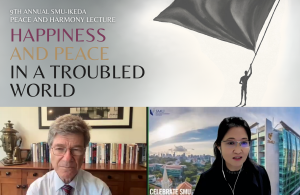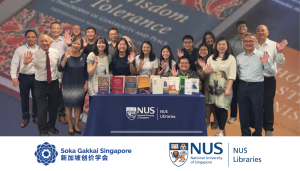Associate Professor Lim Tai Wei
National University of Singapore NUS EAI Senior Research Fellow (Adj,)
Soka University of Japan
The book is written in beautiful prose and language use. There is an attempt by the author to deconstruct ideas about orthodox religiosity and purity in religious practice. The author describes Daisaku Ikeda as a “cosmic citizen” (p. xi). This single quotation probably sums up the impressions and thesis statement of the publication. Both Carter and Ikeda are similar in the sense that they are universal in ideas and eclectic in beliefs. There is powerful ideational inclusion by both men of the universality of humanism and interfaith inclusivity. This single tract is what makes the book such a powerful reading and an insight into interfaith journeys.
The nexus between religious outlook and Martin Luther King’s civil rights movement is skilfully weaved together in the publication. The idea of non-violent civil disobedience that King practiced is contextualized within Gandhi’s own movement. They can be equated with both Carter and Ikeda’s efforts to bring peace and understanding to the world through ideas, implementation of peace and inclusivity of different faiths. Like Gandhi and King, Carter and Ikeda are turning powerful forces for potential divisiveness into inspirational forces for peace by welcoming spiritual leadership of all kinds.
Both preach the idea that, while social changes can be violent like wars, revolutions, racism, different types of physical violence and other human conflicts, they can also be peacefully transformation through persuasion, spiritual reform, and building Ikeda’s vision of a “commonwealth of global citizens” (p. 14). Such goals prompted Carter to start a journey towards studying Ikeda’s ideas to buttress his own Christian beliefs. They were bonded in a “cosmopolitan cause” (p. 19). Carter saw himself as an individual eager to carry on King’s work and create greater awareness of his cause.
No matter how King was spit upon, despised, beaten up, imprisoned and received retaliation for his cause, King returned his haters with love. It is this kind of persistent and constant search for compassion in the eyes of adversity that bonded Carter, King and Ikeda. They were united in the hope that war would never happen again in the same way it affected their family members. Carter’s father saw his best buddy blown away to bits with entrails splat onto his body which he had to clean off. Carter’s father was never the same again after that incident. Ikeda witnessed how his eldest sibling was killed in battle, deeply affecting his mother.
They saw hope and love where hatred, evil and violence once treaded. That journey continues in Carter’s world with his desire for people to accept illegal migrants, gender minorities and many other persecuted individuals (p. 92). Like Carter’s focus on contemporary issues, Ikeda was concerned about youth violence in Japan and he sought Carter’s views on the subject matter. Carter responded by articulating that parental guidance, overcoming popular culture’s embrace of violence and leading by example in the case of parenting are the major panaceas for the social ills.
Carter’s message for peace, inclusivity and acceptance eventually brought him to the doorsteps of Soka University of Japan in Hachioji. Here, he was impressed by the treatment given to his ideas, which was broadcasted to 1000 Soka Gakkai International (SGI) centres throughout Japan (p. 119). Carter was impressed by the fact that Ikeda was so keen to learn more about Carter’s idea when he was expected Ikeda to talk more about his own achievements (p. 121). Carter was clearly a scholar as much as he was a Baptist preacher. He shaped and honed his pedagogical methods and craft by adopting the same principles of being a listener and not just a disseminator.
Carter believed in the power of having dialogues, just like Ikeda. He saw the effectiveness of having a question and answer session where students can contribute as much to the discussion, discourse, narrative, knowledge accumulation and epistemological processes as much as the teacher disseminating the information in the classroom environment. He saw the benefits of cross-fertilization of ideas in bringing different disciplines together (p. 141). Carter’s own academic experience paralleled Ikeda because both of them came from trying environments and literally clawed their way through schooling and education.
The desire to contribute back to education arose from their hardships experienced in their learning journeys. Carter was never inspired to enter Ohio State University despite living near its doorsteps but was given opportunity to learn how to read by a white American teacher, Mrs Josephine Clark, who saw the potential in him and gave him extra lessons (p. 152). Like Carter, Ikeda had a young male teacher who taught his class and took up the burden of cleaning the class so that he could dismiss the students earlier. Young Ikeda stayed back to help this teacher. In both of these examples, the power of inspiring young minds and a source of positive emulation for these kids are embedded into the scholarly and teaching minds of both Carter and Ikeda.
From the many examples above, it becomes clear that Carter and Ikeda’s lives paralleled each other. Both individuals were products of trying circumstances. They saw the evil, the negative and the bad in their environments but were sheltered from the most trying of times by people with good hearts from protective parents, to caring teachers and inspirational teachers/mentors (from King to Gandhi to Toda). Both then adopted inclusiveness and internalized love and understanding in their lives with the objective of inspiring and helping others. While many other chose particularistic means of assistance based on their own religious beliefs and political views, Carter and Ikeda relied on cosmopolitan citizenry to craft their offer of help and contributions.
Underpinning these two great writers is a powerful experiential form of curating and archiving life experiences. In Carter’s case, a biographical work powerfully puts across his views and thoughts in an eloquent and elegant manner, casting it as an encounter with a sensei (which he defined as a master of a craft) while Ikeda curated his encounters in the form of published dialogues (more than 80 as Carter indicated in his book). It was one of these curated works by Ikeda in his dialogues with Toynbee that brought together two humanistic scholars and religious figures, and created this powerful volume that now rests in our hands (or screens if one is reading the Kindle version).

